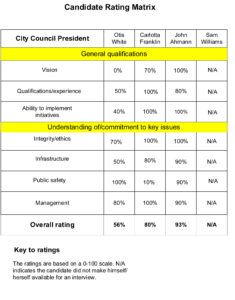When we talk about good management, we’re really talking about two things: Doing the right things and doing them in the right way. The vast majority of management advice is about the second part, doing things in the right way.
But what about the first? How does a government know the right things to do? And what can you do if a government loses its way?
It isn’t a hypothetical question. I’ve seen governments that were lost. Many cities staggered through the 1960s and 1970s, attempting one half-hearted solution after another as their middle classes fled, downtowns declined, and businesses moved to the suburbs. It took decades to find a set of strategies for turning things around.
And today, it seems to me, it is states that are most at risk, due not so much to overwhelming problems as to divide-and-conquer politics and ideology. We’ve seen it recently in places like Kansas, North Carolina, and Wisconsin, where narrowly elected legislative majorities rammed through laws punishing labor unions or gay citizens, recklessly outsourcing public services, or cutting taxes to the point that education funding was in jeopardy.
I’ve detailed elsewhere why some states have lost their way. But a more interesting question is, what can we do now? How do you put a government back on track once its elected officials have jumped the track?
My answer: Take a page from what local governments learned about turning to the citizens. Starting in the 1980s, some cities started convening residents in open-ended discussions about what they needed and wanted, using a process known as “visioning.”
It was based on two principles. First, you ask citizens things they know from their own experiences, such as the kind of city or neighborhood they want to live in. Second, you let them talk about these things first in small groups, and then report out their ideas. The process tends to refine the ideas and ground them in reality.
Out of this process came demands for many of the things that make cities work today: walkable neighborhoods, lively downtowns, new investments in parks and trails, greater collaboration between schools and local government, transit improvements, and bike lanes. In recent years, these conversations have turned up a new concern, that urban success is depriving cities of the human diversity that fuels them.
Could such conversations be held across an entire state? And if so, who should hold them? State legislatures would hardly be the ones to ask citizens how to fix the problems they’ve played such a large role in creating.
The answer to the first question is yes, there’s no reason we can’t scale visioning to the size of a state. As for the second question, I would like to nominate a surprising convener: state political parties.
My reason is simple. Bad politics are at the heart of what ails state governments today. And the way to fix bad politics is with good politics. If one party (probably the minority party) listens to citizens in a systematic way, reports honestly what they say, and builds its legislative agenda around those desires, it will change politics for the better . . . and possibly make a majority out of the minority party. Warning: Running a dishonest visioning process, one in which you stack the meetings with partisans or report only the ideas you like, is worse than running no process at all. My advice: Trust the process.
But trust it to do what? What is it that citizens are likely to say in these meetings? Well, no one can know for sure until the meetings are held, but based on my experience at the local level, they’ll ask for things that can make their lives and communities better. Sensible things like better public schools, greater access to vocational and higher education, more transportation options, help with economic development, and amenities that might help their cities or towns hold on to their young people. For the most part, they won’t demand things that punish other citizens, satisfy extremist groups, or reward special interests.
In this way, citizens can help focus states once more on their serious work in human development, economic development, and infrastructure. This won’t thrill the ideologues. But it’ll delight the citizens.
A version of this posting appeared on the Governing website.
Photo by Josh Graciano licensed under Creative Commons.
